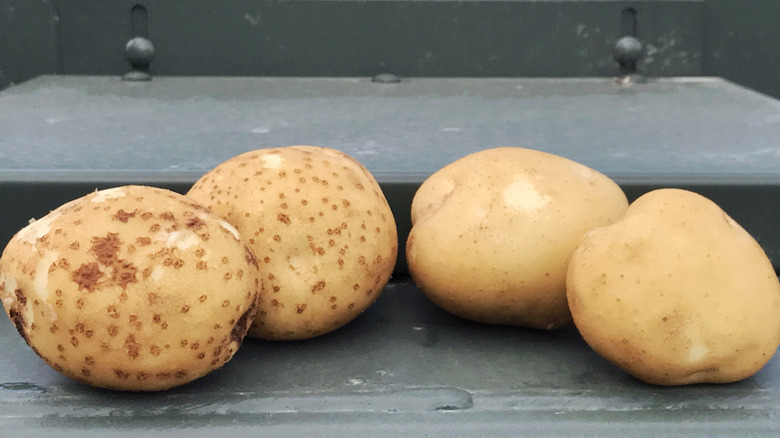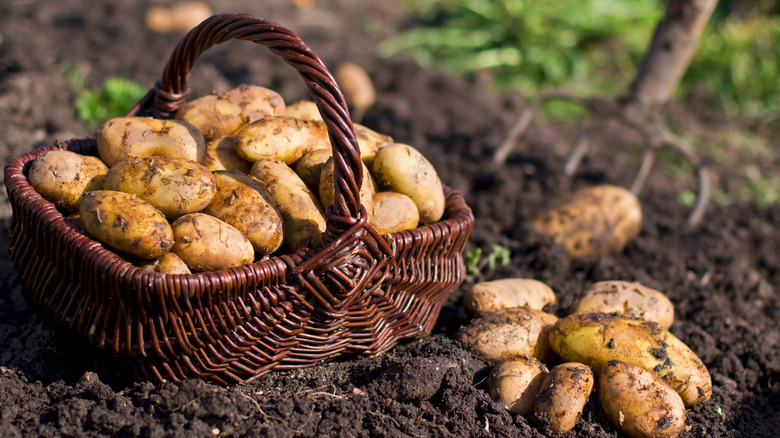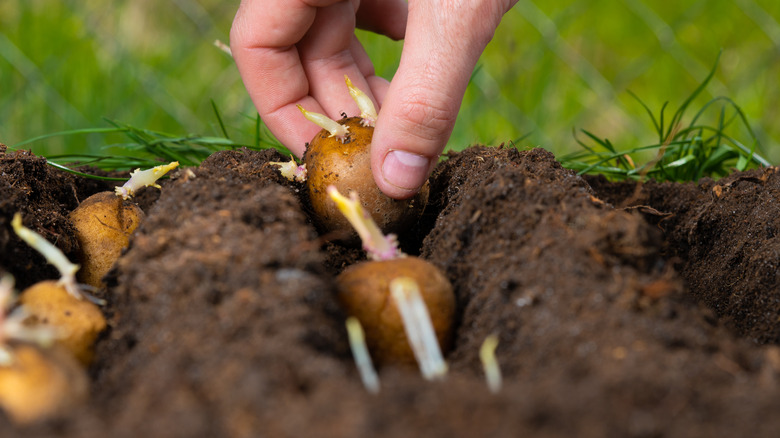The Gross Reason Your Potatoes Have Scabs (And Mistakes That Are Causing Them)
Potato scabs are a common issue in potato farming, and the reason behind them is somewhat gross. The scabs on potatoes are primarily caused by a soil-borne bacterium called Streptomyces scabies. These bacteria thrive in soils with high pH levels and low moisture content, which creates an environment conducive to their growth. When potatoes come into contact with infected soil while they grow, the bacteria can infect the potato tubers through wounds or lenticels, which are small openings on the surface of the potato skin.
Once inside the potato, the bacteria multiply and produce a compound called thaxtomin, which is toxic to plant cells. Thaxtomin disrupts the normal growth and development of the potato tuber, leading to the formation of scabs on the surface. These scabs can vary in size, shape, and severity, ranging from small, superficial blemishes to larger, more pronounced lesions that affect the appearance and marketability of the potatoes.
While potato scabs are primarily a cosmetic issue and do not typically affect the taste or nutritional value of the potatoes, they are unsightly and undesirable to consumers. For this reason, potato scabs can cause economic turmoil on infected farms as their potatoes may not sell well if at all. Accordingly, farmers have developed strategies to mitigate the risk of the bacteria that cause these scabs which can also be used on a smaller scale in your backyard. Responsible farming practices are paramount to the success of your crops.
How to manage soil to avoid potato scabs
Even in a small, backyard garden plot, proper soil management is essential for the health of all crops, but it can also aid in preventing scabs from forming on your precious potato plants. Poor soil management, characterized by high pH levels and low moisture content, creates an ideal environment for the growth of Streptomyces scabies bacteria, leading to scab formation on your potatoes. To avoid this outcome, you should regularly test your soil pH levels and take steps to adjust them within the optimal range for potato growth, typically between 6.0 and 6.5. If you need to lower the pH for a more acidic soil for your potatoes, you can consider incorporating elemental sulfur into your soil before planting your potato crops.
Inconsistent watering practices also play a role in scab susceptibility. Potatoes require consistent moisture levels to thrive, so you should aim to provide regular, even watering, avoiding both drought stress and waterlogged conditions. Proper soil drainage is essential for preventing waterlogging, which can promote the growth of scab-causing bacteria. You should ensure your soil has adequate drainage by amending heavy soils with organic matter and avoiding compacted areas.
Over-fertilization is another common mistake that can exacerbate scab issues. Excessive use of fertilizers, particularly those high in potassium, should be avoided as they can contribute to scab development. By implementing these soil management practices, gardeners can effectively mitigate the risk of potato scabs and promote healthy potato crops.
Planting practices to avoid potato scabs
In addition to caring for and maintaining healthy soil for your potato plants, proper planting practices and seed selection are also crucial for minimizing the risk of potato scabs and ensuring successful potato cultivation. To begin, you should avoid planting infected seed potatoes, as they can introduce the scab-causing bacteria into the garden, leading to scab outbreaks. It's essential to inspect seed potatoes carefully before planting and discard any that show even slight signs of infection. Since this bacteria can survive in alkaline soils indefinitely, it's essential to take this precaution before introducing infected seed potatoes to your garden.
Additionally, poor crop rotation practices can contribute to scab development. Planting potatoes in the same location year after year increases the buildup of soil-borne pathogens, including those responsible for scab formation. To mitigate this risk, you should rotate your potato crops with other non-host plants, like corn or beans, ideally on a three to four-year rotation cycle. Not only will rotating your crops help prevent potato scabs, but it will also foster a more nutritious soil with healthier plants.
Lastly, selecting susceptible potato varieties can increase the likelihood of scab occurrence. Some potato varieties are more susceptible to scab than others, so you should choose resistant varieties whenever possible. Opting for resistant varieties can significantly reduce the risk of scab outbreaks and promote healthier potato crops overall. Alta Rose, Gold Rush, and Russet Burbank are all great choices for your garden.


